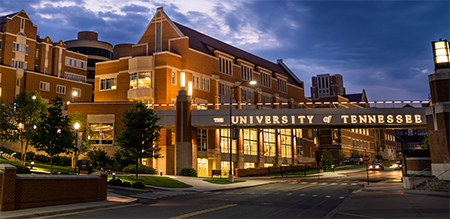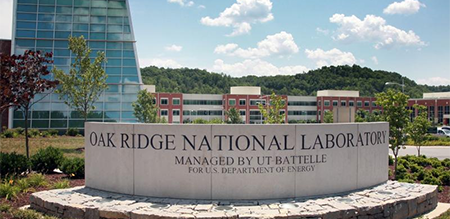NPET Fellowship - Nuclear Physics in Eastern TN


Prof. Nadia Fomin (UT) - Neutron Beta Decay. Neutrons are a fundamental building block of matter that has been under intense study for almost a century. Yet, there is still experimental disagreement about one of its basic properties, i.e. the neutron lifetime. A free neutron decays into a proton, electron, and anti-neutrino in about 15 minutes. However, two traditional methods of measuring this duration give answers that differ enough to have serious implications for Big Bang Nucleosynthesis as well as the Standard Model of Particle Physics. Prof. Fomin is looking for a student to analyze new experimental data with Machine Learning techniques and help design next generation experimental apparatus.
Prof. Kate Jones (UT) - Nuclear Astrophysics. In order to understand how all the naturally-occurring elements in the periodic table were created in the cosmos it is essential to know the rates of the underlying nuclear reactions and decays that produced them in the relevant stellar, or explosive environment. In experimental nuclear astrophysics we use laboratories on Earth to measure reactions rates, or the properties of nuclei that inform those reaction rates. The nuclear reactions group at UTK, uses laboratories at Michigan State University - soon to include the Facility for Rare Ion Beams (FRIB), Argonne National Laboratory, and the University of Notre Dame, as well as state-of-the-art particle and gamma-ray detectors to measure the reactions of short-lived nuclei.
These experiments involve planning, including calculations and simulations, setting up detector systems, running the equipment during the beam time, calibrating the detectors, analysis of various reaction channels, and comparing with theoretical calculations. We also design and build detectors in our laboratory on the UTK campus. An undergraduate student joining us for a Summer could be involved in any of these tasks, depending on their interests and the stage in the process that our experiments are in at the time. Each of these tasks require various skills, including computer programming, running complex calculation and simulation codes, CAD design and prototyping with 3D printing, and detector handling. These skills will be taught and monitored by a postdoc, or graduate student in the group.
Prof. Miguel Madurga (UT) - The decay of the 11Li neutron halo and cluster effects in 11Be. The observation of spherical, tightly bound “magic” nuclei was key to confirm the existence nuclear orbitals akin to atomic shells. For four decades this paradigm was success-fully used to describe nuclear structure and reactions of most known nuclei. Of course, Nature had different plans. The observation of highly deformed magic nuclei in the so-called island of inversion around Mg-32 prompt a revolution of our understanding of the effect of non-spherical residual interactions in nuclei. The revolution initiated by the discovery of the island of inversion provided the framework to understand the sudden onset of deformation in other lighter and heavier nuclei. In the summer of 2021 we will measure the decay of 11Li into 11Be, a super-deformed isotope of beryllium. The experiment will measure for the first time coincident neutron-alpha emission to elucidate the effect of alpha-clusters in the deformation of beryllium. Multi-particle detection experiments are some of the most challenging in nuclear physics, requiring specialized analysis tools. The summer student will work on detector and analysis preparation in advance of the experiment. The experiment is scheduled to run at the end of August, beginning of September 2021, and pending COVID travel limitations, the student will participate in experiment assembly and data taking.
Prof. Andrew Steiner (UT) - Nuclear Physics of Neutron Stars. The next summer student who works with Steiner will compute the posterior distribution of the neutron star maximum mass as a function of the spin frequency. This posterior distribution is particularly important in light of the recent LIGO discovery of GW 190814, a merger of a 23 solar mass black hole with a 2.6 solar mass object. If the 2.6 solar mass object is a neutron star, it will provide strong evidence for strong rotation in massive neutron stars.
Prof. Christine Nattrass (UT) - Partonic Energy Loss in the Quark Gluon Plasma. A hot, dense form of nuclear matter called a Quark Gluon Plasma (QGP) is formed when nuclei are melted in high energy nuclear collisions. This matter is now understood to be a liquid of quarks and gluons which flows as it expands and cools. This matter is nearly opaque to fast quarks and gluons. These partons lose energy as they traverse the medium. As they exit the medium, they form collimated showers of hadrons called jets. This loss of energy as partons move through the QGP is called jet quenching. The JETSCAPE collaboration has developed a software framework to simulate all stages of these nuclear collisions.
Since the JETSCAPE framework allows simulation of a complete nuclear collision, it allows models to be treated like data for the first time. This can be done using Robust Independent Validation of Experiment and Theory (RIVET) toolkit, a software framework which can be used to implement experimental analyses in a model-independent way. RIVET only recently added functionality to enable high energy nuclear collisions, so there are few heavy ion analyses available for comparisons to data. Students will work on implementing analyses in RIVET so that the JETSCAPE collaboration can compare their data to a wider range of experimental data.
Dr. Leah Broussard (ORNL) - Detector Characterizations for Neutron Beta Decay Measurements. The beta decay of the free neutron, the simplest ‘nucleus’ to undergo a ra-dioactive decay, is an excellent laboratory for understanding the electroweak force. By precisely measuring properties of the decay and comparing to theoretical predictions, we can search for the influence of possible undiscovered particles or new forces of nature. The Nab experiment uses state of the art detectors to observe the electron and proton emitted in the decay of unpolarized neutrons. The trainee will learn to use Python on CPU and GPU to process detector signals, analyze simulated and real data to perform energy calibrations and study timing performance, and use statistical methods to estimate uncertainties of systematic effects. In-person projects include operating the detector testing apparatus, optimizing the data acquisition system for de-tector tests, and participating in the Nab experiment operations and data-taking. As a result of this effort, the Nab experiment will have improved understanding of the performance of its detection system and how uncertainties may contribute to the final experiment goals.
Dr. Kelly Chipps (ORNL) - Nuclear Astrophysics Measurements with Gas Targets. When performing nuclear reaction measurements in inverse kinematics (heavy beam, light target), as is necessary for radioactive ion beam studies such as those planned for FRIB, ARIEL, and FAIR, the target thickness and purity become paramount. The energy and angular resolution of a measurement, and the signal-to-noise of the extracted particle spectra, are highly dependent on the quality of the target material used. For light-ion-induced reactions such as (d,p), (p,3He), etc, a dense, localized, and pure target of hydrogen or helium gas is required; a gas jet target provides this. Performing inverse kinematics measurements inside of a solenoidal magnetic field, as is done with the HELIOS device at Argonne National Lab, improves the resolution of the particle spectra by removing the issue of kinematic compression. Combining the two technologies - a gas jet target with a solenoidal magnet - has the potential to greatly improve particle spectroscopy. In this project, the trainee will build a simulation package for gas jet target systems, using linked codes and shared input files, and create a graphical user interface and visualization capability. This package will be provided to the low energy nuclear physics community to help with planning experiments with the SOLSTISE and SOLARIS gas jet target systems. In person components of the project include assisting with the design, construction, and characterization of a new gas jet target system for use inside of solenoidal spectrometers.
Dr. Andrea Delgado (ORNL) - Quantum Machine Learning Applications to Nuclear Physics. Heavy-ion collisions at high energies result in a phase transition where quarks and gluons are no longer confined into hadrons. As a result, a little fireball is formed, in which everything melts into a quark-gluon plasma. This plasma instantly cools, and the individual quarks and gluons recombine into a blizzard of ordinary matter that speeds away in all directions. This ”spray” of hadrons is usually referred to as a jet. Identifying jets formed in high-energy particle collisions requires solving optimization problems over a potentially large number of final state particles. Quantum computing holds the promise of speeding up some data analysis tasks, such as the efficient and accurate clustering of particles into jets.
This project focuses on using quantum-assisted techniques for jet clustering to access the quark-gluon plasma’s microscopic structure by probing it at shorter and shorter length scales at which the free quarks and gluon degrees of freedom should emerge.
Dr. Steven Pain (ORNL) - Nuclear Astrophysics Experiments at National Accelerator Facilities. The Nuclear Structure and Astrophysics Group in the Physics Division at Oak Ridge National Laboratory has opportunities for students to work on experiments and instru-mentation for accelerator-based nuclear astrophysics experiments investigating nuclear reactions involved in stellar and explosive nucleosynthesis. These experiments use radioactive and stable beams at National Laboratory and University facilities across the US, including the ATLAS Fa-cility at Argonne National Laboratory, the Nuclear Science Laboratory at the University of Notre Dame, and the High Intensity Gamma Source at TUNL, and the nascent next-generation radioac-tive beam facility FRIB. The experiments employ instrumentation developed at ORNL, such as the GODDESS particle-gamma spectrometer (using Gammasphere and GRETINA) and OR-RUBA silicon detector array (orruba.org), the JENSA supersonic gas-jet target (jensa.ornl.gov), and arrays of advanced neutron detectors including SABRE and ODeSA. Opportunities avail-able include detector/instrument development for radioactive beam physics, involvement in the experimental program, and analysis of experimental data, simulation and analysis coding, with instrumentation projects including development of a cryogenic hydrogen target and an active gas target.
Dr. Vince Cianciolo (ORNL) - Search for the Neutron Electric Dipole Moment. How round is a neutron, and why does anyone care? It turns out that the neutron is very round indeed – to better than a part per trillion. Nevertheless, even more precise measurements of the neutron shape are being pursued with great urgency because that shape may be able to lead us to the answer to a profound question: Why is there any matter in the Universe? Depending on interest and experience undergraduate interns could contribute to this enterprise in a number of ways: developing computer code to simulate and analyze data, developing control software needed to test a specialized low-temperature valve, testing components of a system used to measure the energy and arrival time of a small optical signal, developing CAD drawings of experiment components for machine shops, helping to assemble and test a massive vacuum vessel. Each student will be mentored by a staff member in the group and can expect daily interaction.